Getting your cat used to being outdoors
Cats that are allowed outside are able to use their natural instincts, for example sneaking up and pouncing, chasing and hunting, much more intensively than cats that have to stay indoors. However, allowing your pet to go outside should be a very gradual process starting with a sufficiently long familiarisation phase.
When should a cat be allowed outside for the first time?
If you have brought a kitten into your home, it should not be allowed outside for the first few months. This should not happen until your pet is at least eight months old. Some cat owners even wait until their cat is almost a year old.
Even if you adopt an adult cat or have just moved house, it is advisable to wait a while before letting your pet go outside. You may be faced with a tricky situation if your cat has previously been used to going outdoors and is now no longer allowed to. Your cat may find this very hard to understand and may react accordingly. If you are planning to let your cat go outside again, you should wait a while and provide it with a variety of play activities to keep it occupied in the meantime. Only when you have the feeling that your pet has really accepted its new home, should you consider letting it outdoors. This will usually take at least three to four weeks.
What are the advantages and disadvantages of letting your cat outside?
Cats love sneaking up and pouncing, chasing, and hunting. They can also do this indoors with toy mice or another cat, but it is far more exciting outside. Here, cats can mark out their territory and inspect it every day. They know where it is best to go hunting, where their friends and adversaries live, and where they can sometimes find a bowl that has been put out for them.
Every day they have to reckon with almost anything, so they have to move around with all their wits about them. This provides perfect exercise, both mentally and physically. Cats that are allowed outdoors are therefore less likely to be overweight and thus live healthier lives. However, despite the many advantages, it is important not to forget the disadvantages. These include the dangers of traffic, contracting an infection from other cats, fights over territory, being poisoned, and even the cat disappearing, or being shot.
What do I have to bear in mind if I allow my cat to go outside?
Before you let your cat go outdoors for the first time, you should consider several things:
- First of all, there is the question of whether you can let out your cat without compromising its safety. If you live near a busy road, then this is not the case. A large number of cats are injured or killed by traffic every year. As already mentioned, this is one factor that significantly reduces the average life expectancy.
- All outdoor cats should be vaccinated. The German veterinary vaccination commission (StIKO Vet.) recommends vaccination against feline panleukopenia, cat flu and rabies. Depending on the individual situation, vaccination against feline leukaemia and Bordetella bronchiseptica is also recommended.
- To avoid infecting themselves and others, outdoor cats should be dewormed on a regular basis. If they often come home with parasites in their fur, a spot-on product is also advisable.
- Some countries and districts have cat protection bills and ordinances in place. Find out if this is also the case where you live. Although such legislation – which involves the cat being tagged, registered and neutered – is not yet the norm throughout Europe, it can nevertheless be recommended.
- If your cat is microchipped and registered in a national microchip database, it can be traced back to you. This is important in case your cat runs away and someone finds it and hands it in.
How can I get my cat used to being outdoors?
When you let your cat outside for the first time, it should not have a full tummy and it should not yet be early evening. Give your cat less than usual to eat in the morning and venture outside together for the first time at some point during the day. Have some of your cat’s favourite treats ready and remain calm and relaxed. Lure your pet outside, keep talking to it, and stay on the patio or near the entrance to your home. Do not rush your cat, but at the same time avoid running after it if it suddenly approaches the edge of your garden. Everything should be calm and harmonious in order to make sure that you pet feels safe. Follow your cat slowly, show it the surroundings and then wait and watch. If it wants to go in again after a few minutes, show it that you are happy about this and give your pet a reward. It must realise that it is always welcome to come back inside.
At first, you cat will probably only stay outside for a relatively short period, because cats tend to expand their territories slowly over time. Initially, you should stick to only allowing your cat outside when it has eaten nothing more than a small snack. It is then all the more likely that after a while it will be hungry and eager to return home. It is similar if it is drizzly outside, so it is no problem if the weather is not at its best.
Over the next few days and weeks, you will be able to see how often your cat wants to go out and how long it will tend to spend outdoors. If this is difficult to fit into your daily routine, you may want to consider getting a cat flap. You will then no longer have to work as a door attendant, but depending on the model, will also be able to set the cat flap to allow only your cat in and out, and to remain closed at a specific time (in the evening). This is made possible by a reading device that recognises your cat’s microchip. This type of cat flap can be especially recommended if other cats in the area are not afraid of invading your pet’s territory.
Tip: It is best to get your cat used to the fact that it will only be allowed out in the day, and that the door or cat flap will remain firmly closed in the evening. In this way, you will not only minimise the risk of something happening in the dark, but you will also be able to sleep more peacefully.
How far away do outdoor cats tend to go?
The radius in which outdoor cats move around can vary a great deal. Some rarely stray any further than 100 metres from their homes, while others regularly wander off as far as a kilometre away or more. This depends on a number of different things: In a busy city with lots of “obstacles”, the radius will tend to be smaller than in the countryside. It also depends on, for example, whether your pet is a farm cat (who is used to being able to roam around freely) or a purebred cat.
Another important factor is whether the cat is neutered. A neutered cat will usually have a smaller territory and will get into far fewer fights. Both for this reason and to avoid unwanted offspring, all cats that are allowed outdoors should be neutered.
Are outdoor cats healthier?
Cats have deeply embedded instincts, many of which they can make better use of in a natural environment. However, this does not automatically mean that all outdoor cats are happier and healthier than those that have to remain inside. In fact, the opposite is often the case! Cats have to defend their territory and may be attacked, injured or chased away by other cats. Such confrontations also always involve the risk of bacteria, viruses or parasites being transmitted and making you cat ill.
In addition, numerous cats are run over by cars or even shot every year. As lovely as life for an outdoor cat may be, the dangers are manifold; something that is reflected very clearly in their life expectancy: While indoor cats reach an average age of 15, cats that are allowed outdoors only live to be 10 years old on average.
You may also like this

Moulting in cats
How to help your cat during moulting

Territorial behavior
Territorial behavior of outdoor and indoor cats

Neutring for cats
Neutring has many advantages

Ticks on cats
How to safely remove ticks from your cat
